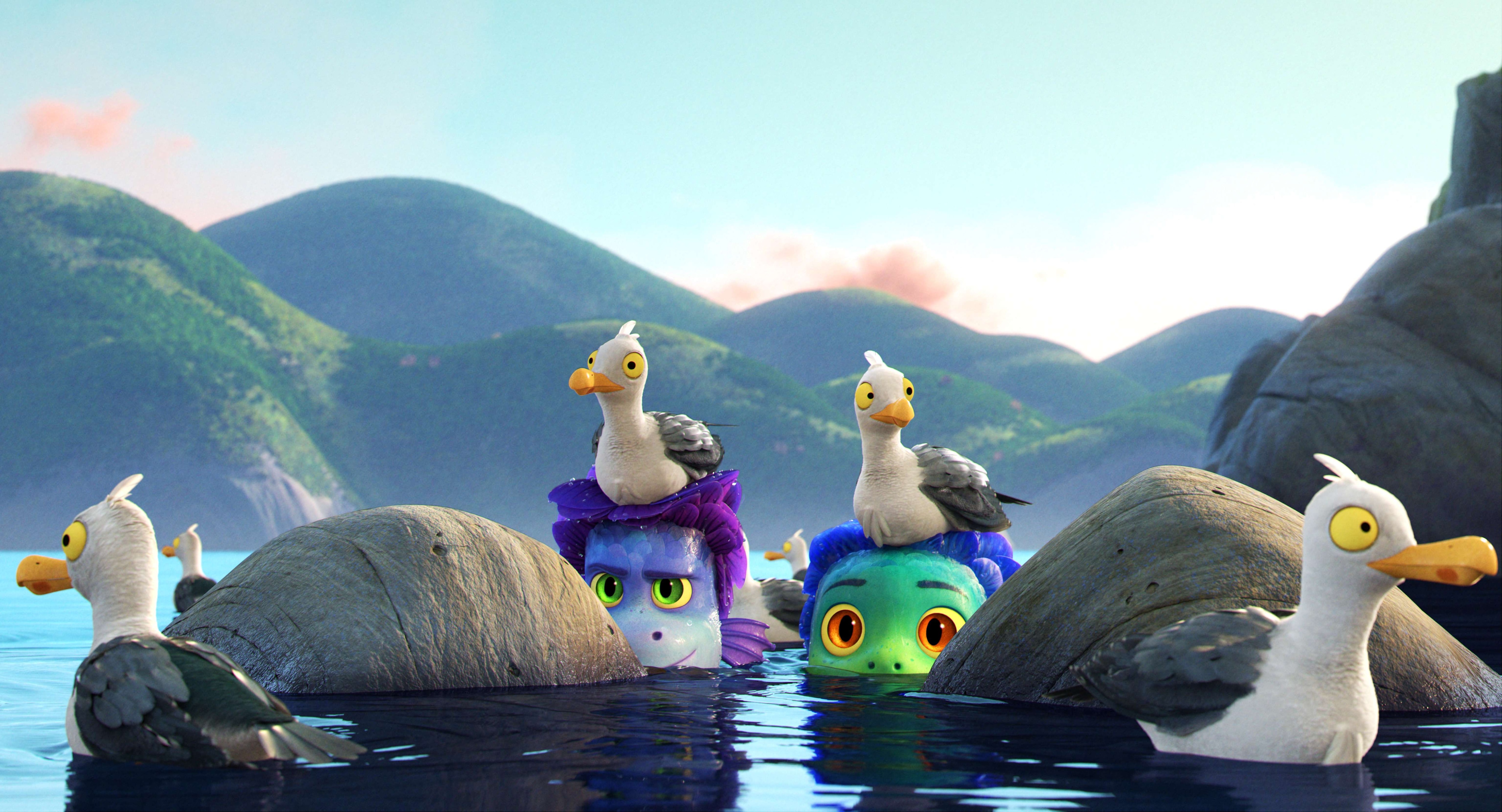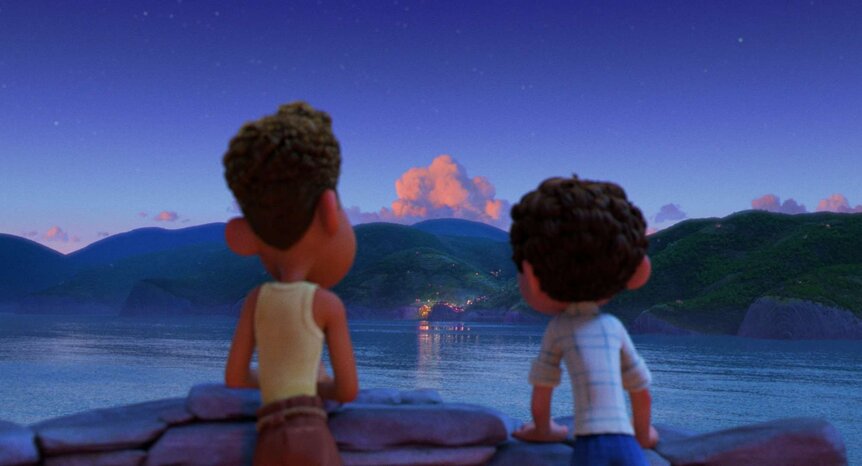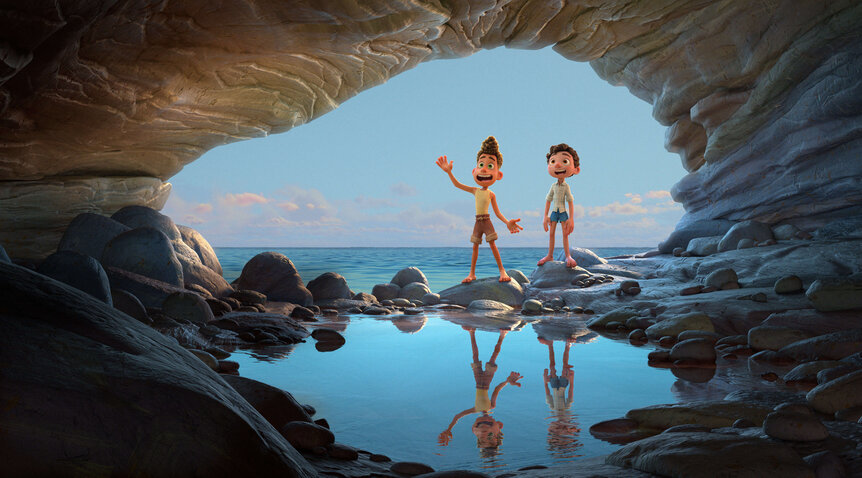Create a free profile to get unlimited access to exclusive videos, sweepstakes, and more!
'We had to take a leap out of our comfort zone': How Pixar's 'Luca' continues to push the boundaries of animation

Nearly two decades ago, Pixar changed the animation game with the release of Finding Nemo, which brought our planet's oceans to life like never before. The depiction of water was so realistic, in fact, that it actually had to be toned down for the finished movie. "What we do at the studio is caricature and it would look funny to have cartoony caricatures of fish in this realistic world," supervising animator Dylan Brown remarked in a 2003 interview. "We didn't want to fool the audience that they are in a real world. You have to believe you are underwater, but it doesn't have to be photo-realistic to do that."
Now, 18 summers later, Pixar is once again looking to wade into the thrashing waves of aquatic innovation with Luca. Helmed by Enrico Casarosa (the director behind 2011's Oscar-nominated short, "La Luna"), the film revolves around Luca and Alberto, a pair of young sea monsters (voiced by Room's Jacob Tremblay and Shazam!'s Jack Dylan Grazer) enjoying a youthful summer of discovery on the Italian Riviera. "This is kids having fun and I wanted it to be like jumping into a kid's book," Casarosa explained at a virtual press event attended by SYFY WIRE.
That sentiment guided the entire production, which also swam against the current of photo-realism, to create new tools that would evoke a 2D and near-mythical aesthetic within a 3D environment. Easier said than done, as the Disney-owned studio had gotten into a comfortable rhythm of animation techniques that were only improving with each year.
"It turns out elegant simplicity is actually really hard to achieve," VFX supervisor John Reisch said. "At Pixar, especially in our effects department, we're very comfortable with realism. We know how to achieve that look. If you remember the beautiful water work in Finding Dory or some of the grounded, gritty realism of Cars 3. And to be honest, stepping toward stylization in our effects work was sort of a hard left turn away from everything we knew."
"There were a few touchstones we kept coming back to," Reisch continued. "Certainly the artistry of Miyazaki and Studio Ghibli, but also these Japanese woodblock paintings with their suggestive details that guide the eye with certain simplified forms, shapes [and] very clear silhouettes and sinuous reflections. All of which we wanted to capture in the look of our stylized water. We wanted our effects elements not to just integrate into this stylized world and look plausible, but to truly enhance the world that we were creating with their visual language and ultimately support the storytelling and Enrico's artistic vision."
"I find that sometimes, a lot gets thrown at us in detail, and I was really just trying to make it rich, but also trying to make it designed and beautiful," Casarosa said, responding to a question from SYFY WIRE. "So much of this movie is about a kid experiencing things for the first time and I wanted a sense of the light and wonder to really be part of this movie, in all its details, because it's really someone who's in love with discovering the world."
Luca's carefully designed water effects stand as a testament to Pixar's uncanny ability to break new ground with each project they decide to tackle. "In a lot of ways, we felt… our whole world was being turned upside down. All the answers that had been right before were wrong for this film and that new look we wanted to deliver on," Reisch admitted. "We had to take a leap out of our comfort zone and away from our instincts to deliver on something new."
As a guitarist who's played in bands for nearly 30 years, the VFX supervisor landed on "this thought about controlling the ocean and the different frequencies in it like a graphic equalizer controls your stereo ... we built sliders that allowed us to mix in more or less of a certain-sized wave. That really started to crack open this idea of injecting artistic control. Now, we could dial in less of the high-frequency detail we were looking to tamp down and emphasize some of these middle frequencies where we really started to see those beautiful sinuous reflections that we were chasing from the Japanese woodblock prints."
"We have wonderful, wonderful stuff that you haven't seen yet, but, in moments of the movie where the emotion comes out, where the water supports it. Where the waves support it. Where the weather supports it," Casarosa added. "We have more control, and we were able to really try something a little bit different that looks a little different. To feel the most emotion and have it a little less realistic and more stylized. And there's a playfulness to it, a lyricism to it that I was after."
In addition to bringing the waves under their control, Reisch and his team also created a new process for splashing water. "This again is where we really had to challenge our instincts and pull away from this hyper-realistic look that our toolset makes very easy to hit," he said. "We went back to the drawing board and came up with a separate workflow we referred to as ‘cartoon splash.' Instead of allowing the physics of the way that Alberto or Luca collide with the water to dictate the shapes and silhouettes of our splashes, we literally sculpted these clean, graphic silhouette shapes that we wanted and injected those sculptural shapes back into our simulation software."
This resulted in splashes that were less fussy than they might be in the real world. "There's a less distracting detail of the splash particles going everywhere," Reisch added. "Now we're headed back towards that elegant simplicity of our film. You'll also see the bright-white silhouette edge and the blue coloration of the interior of the splash as well, which is another homage to the 2D anime influences on which we drew inspiration."
Getting the colors of the sparkling Mediterranean waters just right fell to production designer Niketa Roman, who took a pre-COVID trip to Italy for research purposes. “We ... went on fishing trips, we took a lot of dips in the sea," she said. "It's really important to do that because we wanted to capture what makes the Mediterranean so unique, especially the colors. The depths of the blues and the greens — it's such a beautiful and unique place."
"Our team worked hard to make sure that this water felt like it was from the Mediterranean versus tropical water or other settings," producer Andrea Warren explained. "We wanted to make the audience feel like they went to Italy ... I know there's the murk of the water and some of those details that are a part of the setting."
Leaning into the "murk" played into the project's overall theme of discovery as Luca defies his overbearing parents — voiced by Jim Gaffigan and Maya Rudolph — to explore the bright and cheerful surface world. Once out of water, Luca and his newfound friend (directly based on Casarosa's childhood buddy), look like any other human boys.
"The beautiful water, a little bit when you're in it, the murk is present. It's a beautifully colorful murk," the director concluded. "We also used that to represent, for our character, a little bit more of a limited world. We used it is to say, actually, the underwater world doesn't enable our protagonist to see as far. We love that kind of sense of sharpness that happens once we're out on the surface. Since this journey is about seeing more of the world, we also thought that it was the specificity of the place [that] represented a little bit of a world that is not as spacious down there."
Luca dives onto Disney+ on Friday, June 18.




























